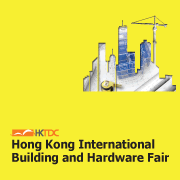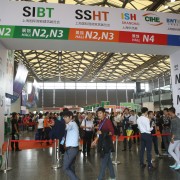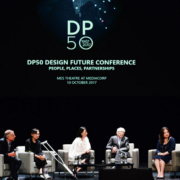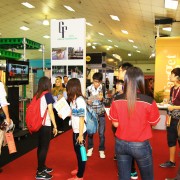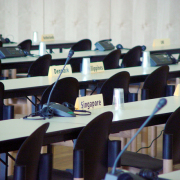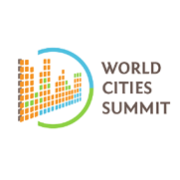IV Moscow Urban Forum Review: No Economic Problems Can Stop Moscow’s Further Development
The Fourth Moscow Urban Forum “Drivers of City Development” concluded on a high note, reaching a consensus that people are the main driver for Moscow and Russia, and a strategic spatial plan has to be implemented in order to stimulate its development.
Held on December 11–14 2014 at the Moscow Manage, the forum serves as an annual platform for the exchange of views and experiences in the context of global urban trends. It was well-attended by around 5,000 delegates from 45 countries, 22 official delegations, 13 mayors of global cities, as well as six heads of administration of Russian cities. The first two days featured 22 general and four plenary sessions, and three special events; the topics of the Forum covered a variety of developmental aspects of modern cities, catalysts of their economic growth, their role in the development of their respective countries and their place in the global infrastructure of the world.
Sergey Sobyanin, Mayor of Moscow, believes that infrastructure development allows the city to grow and evolve, urging that all main areas in the development of the megacity be preserved i.e. improvement of the transport infrastructure, transformation of industrial zones, and development of public spaces. The Mayor also emphasized on people being the main driver behind its development. The capital has all the pre-requisites for the development of human potential. The high-tech sector, multimedia and IT are among the priority areas in the development of the city.
Singapore as a Partner City
This year’s Forum has become the first to have an official partner, which was one of the largest and most advanced cities in the world—Singapore. The head of the Singapore delegation was Mr Teo Ser Luck, Minister of Trade and Industry.
“The Deputy Mayor of Moscow is very keen and supportive in working with Singapore,” Mr Teo told Building Review Journal during a face-to-face interview. “After discussions, we have plans to set up a working group between Singapore and Moscow city. We will look at infrastructure projects in their city development and come together to bring Singapore investors and businesses to explore those opportunities,” he added. With the positive outlook and good friendly relations between Singapore and Moscow, Mr. Teo reckons businesses in Singapore can have confidence and some assurance to explore opportunities within Moscow.
Climbing New Heights
Two years ago, the territorial Moscow has grown by 160,000 km2. Those new cities – often referred to as the ‘New Moscow’ holds great potential for Moscow’s urban development plan.
“Moscow had undergone significant changes in recent years. Many of the projects have already proceeded from the planning stage to implementation,” said Mayor Sergey Sobyanin during a plenary session on December 12 entitled “Moscow’s Priorities for a New Stage of Development”.
Large-scale construction is gradually transforming the market: Moscow has shifted from the perception of a heavily overpriced city for business travelers and tourists, to an opportunistic and affordable city. In recent year 2013, the capital had a record-high number of foreign visitors, which exceeded 5 million. The reform of the urban planning policy and a new spotlight of attention, said the Mayor, will enable Moscow to maintain the current level of new development without the need to squeeze new buildings into areas that are too dense for that.
By 2020, the New Moscow will cater living spaces for a population of 1.5 million, and 1 million work places. The volume of investment is about US$ 200 billion, revealed Marat Khusnullin, Deputy Mayor of Moscow for urban planning policy and construction.
In addition, a new study “From Moscow to Sao Paulo”, conducted by PwC, was discussed during the forum. The study reveals development trends of the largest cities in seven major emerging economies. According to Hazem Galyal, a PwC partner, Moscow is climbing up in the rankings of developing cities. Over the last year, Moscow has improved its indicators in respects of safety, transport, and healthcare. It came first in PwC’s rating of cities in terms of information technology and multimedia development.
During the second Forum day, Sergei Levkin, the Head of the Moscow’s Urban Planning Policy Department spoke at a session entitled “Industry in the Contemporary City: Convert or Innovate?”, and noted that industry was the driver of Moscow’s development in the 20th century – these include heavy industry, but in recent years the capital has been changing in line with global trends. Levkin sees the industrial zones as a unique reserve for the city’s development, which can become a perfect tool used for the benefit of the city and its inhabitants; these areas have an opportunity to turn into high added value facilities.
Moscow’s other great resource is the Moskva River embankment. The results of the competition for the concept of waterfront development were announced during the forum. The winner was the Meganom architectural bureau. According to the plans of the Government of Moscow, the project is to be completed by 2035.
Conclusion
At the final session of the Forum entitled “Choosing the Right Development Targets and Frameworks for a Contemporary Megacity,” the participants summed up the outcomes of two days and tried to find an answer to the question of how to establish cooperation between all the parties involved in the development of the megacity to achieve the established goals. The strategy of the city development has to be prepared with the due consideration of many factors, such as space, economy, infrastructure, culture, and, most importantly, the people.
Marat Khusnullin, once again, emphasized that the main driver for Moscow and Russia as a whole are the people who are interested in changes and strategic planning and, most importantly, are willing to participate in the whole process. Marat Khusnullin is convinced that Moscow is a very strong city, and no economic problems can stop its further development.
The IV Moscow Urban Forum had expanded its agenda this year, and is looking to expand its agenda further again next year.
- First plenary session panel
- Mayor Sergey Sobyanin addressing the first plenary session
- Manege Hall
- Mr Teo Ser Luck sharing Singapore’s story
- Singapore delegate – Mr Teo Ser Luck
- Singapore’s booth at the forum









